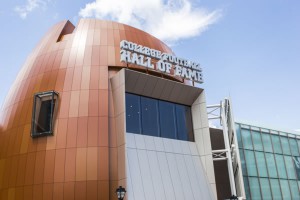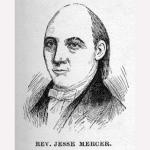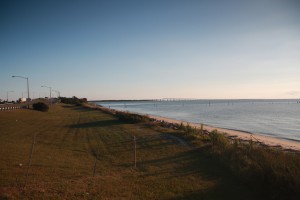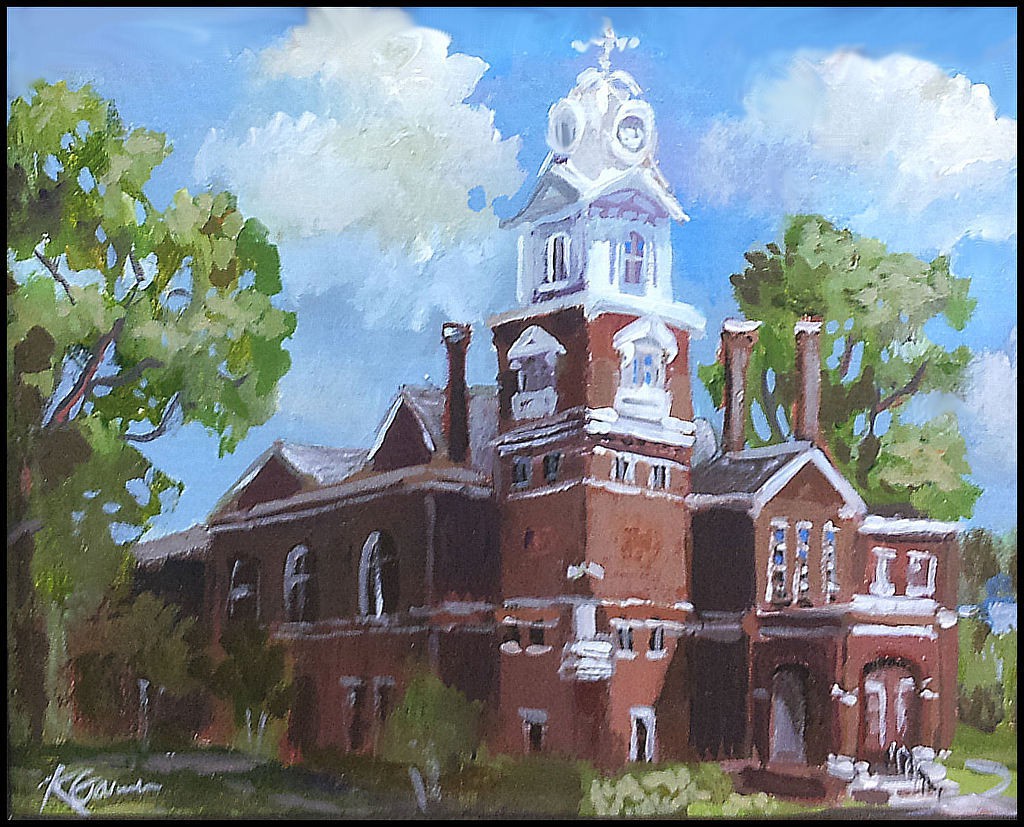COURTHOUSE PAINTING: Few people in Gwinnett will have trouble recognizing this, the Historic Courthouse on the square in Lawrenceville. This is a painting by one of today’s letter writers, artist Karen Garner of Dacula. It hangs in the office of Assistant Superintendent of Schools Jonathan Patterson.
Issue 14.96 | March 10, 2015
IN THIS EDITION
TODAY’S FOCUS: Gwinnett Tech Offers First Georgia Degree in Business Management
EEB PERSPECTIVE: Visiting the College Football Hall of Fame, New in Atlanta
FEEDBACK: Two Letters Concerning the $50,000 Hudgens Prize; Lent Explained
UPCOMING: Fast Electric Charge Coming to Suwanee; Grayson Arts; White House Internship
NOTABLE: Gwinnett Native Heads DNR Division; White House Internship
GEORGIA TIDBIT: Georgia Baptists Found Mercer University, Move It to Macon
TODAY’S QUOTE: Why He’s Sad He’ll Miss the Funeral
MYSTERY PHOTO: Only One Reader Recognized Chesapeake Bridge and Tunnel
TODAY’S FOCUS
GT offers first Georgia associate degree in business management
By Dawn Urrutia
LAWRENCEVILLE, Ga., March 10, 2015 — Gwinnett Tech is launching the state’s first accelerated associate degree program in business management, enabling students with prior professional experience to earn their degree in just one year.
The Professional Accelerated Business Management Degree program will start in Fall Semester 2015 with classes beginning in August. The priority application deadline for Fall Semester is June 25. Visit www.GwinnettTech.edu/apply.
 Jermaine Whirl, dean of business and art and design, Gwinnett Tech, says: “The program mirrors all the best aspects of executive MBA programs, but we’re making that type of experience available at the associate degree level to prepare front line managers to advance in their career.”
Jermaine Whirl, dean of business and art and design, Gwinnett Tech, says: “The program mirrors all the best aspects of executive MBA programs, but we’re making that type of experience available at the associate degree level to prepare front line managers to advance in their career.”
The program targets entry-level managers who have been designated by their employers to be prospective leaders within their individual organizations, said Whirl. The college is working with several area companies who will be covering program tuition for their managers, but the program is also open to any individual who meets the admission requirements.
Program features include:
- Small (20) cohort-based learning;
- Boardroom-style class environment;
- Guest speakers;
- Company site visits and field trips;
- Eight-week mini-semester class scheduling; and
- Convenient scheduling (Friday evening, Saturday morning and online classes).
In addition to an associate degree in business management, graduates will also earn certificates in management and leadership and in human resource management.
Whirl adds: “We have strong support for the program from many regional business partners who serve on our college advisory boards. Their input helps ensure that the curriculum is relevant to the needs of business and industry – today and in the future.”
Gwinnett Tech’s business faculty includes instructors with 20-plus years of experience in their fields with specialties in entrepreneurship, international business, finance, strategic planning, economics, marketing and information systems.
Admissions requirements include three or more years in a professional leadership role plus the prior completion of certain general education courses. Applicants will also complete an interview process and provide two letters of recommendation. One must be from the applicant’s employer.
Applications are now being accepted for the fall class. Contact Jermaine Whirl at 678-226-6829, jwhirl@gwinnetttech.edu, for more information.
Gwinnett Tech offers more than 50 degree, diploma and certificate options that can be completed in two years or less.
- For more information, visit www.GwinnettTech.edu or call 770-962-7580.
- Get the latest news about Gwinnett Tech: http://www.gwinnetttech.edu/news.
EEB PERSPECTIVE
Area will benefit from College Football Hall of Fame moving to Atlanta
By Elliott Brack, editor and publisher, GwinnettForum.com
MARCH, 10, 2015 — Call the building “The Helmet,” for that’s what it looks like, a three-story football helmet, painted orange. It’s located on Marietta Street across from the Atlanta Chamber of Commerce and adjacent to the Georgia World Congress Center.
 Its official name is the College Football Hall of Fame, and Atlanta landed a gem of a tourist attraction with this facility. For years the College Football Hall of Fame has bounced around at several locations, the most recent being in downtown South Bend, Indiana, certainly a football haven. But it wasn’t located near the University of Notre Dame, and suffered from lack of attendance.
Its official name is the College Football Hall of Fame, and Atlanta landed a gem of a tourist attraction with this facility. For years the College Football Hall of Fame has bounced around at several locations, the most recent being in downtown South Bend, Indiana, certainly a football haven. But it wasn’t located near the University of Notre Dame, and suffered from lack of attendance.
It opened in Atlanta in August, 2013, a $68 million structure. Both Atlanta and Dallas were picked by the Hall of Fame board to bid for its location, and Atlanta, with help from several major corporations, won this bidding war.
The College Football Hall of Fame is open from 10 a.m. until 5 p.m. (on Saturday it opens at 9 a.m.). The best time to go is during the middle of the day, though it never seems crowded at any time. The Hall limits attendance to 1,200 at any time, though its size will allow up to 3,000 in the Hall.
Perhaps the most extraordinary feature of the Hall is the interactivity which is built into every visitor’s experience. When entering, you get a badge to wear with a microchip embedded in it. As you register, you wave the badge at the computer, and it remembers who you are. Each time you approach an exhibit, the badge tells the exhibit your name, which then lights up on screen with: “Welcome, Elliott.” Now it is ready for your interactivity, remembering what you score on each exhibit.
 You also pick at registration your college football team. Later when you visit a 60 foot wide screen on the second floor, you see many, many football images on it. As you approach the giant screen, your alma mater’s football pictures appear in front of you! Amazing! That continues as you tour the other second floor exhibits.
You also pick at registration your college football team. Later when you visit a 60 foot wide screen on the second floor, you see many, many football images on it. As you approach the giant screen, your alma mater’s football pictures appear in front of you! Amazing! That continues as you tour the other second floor exhibits.
On the third floor the members of the Hall of Fame are enshrined, by school. Again, your badge tells the exhibit to show your school members. You can also check out other Hall of Famers at other colleges. And do you know which college has the most members of the Hall of Fame? (Think…….answer below.)
The one experience most visitors to the Hall remember is on the first floor, where a full-sized goal post allows visitors to try to kick an extra point. Several employees are there to help. It’s fun to watch kids and grown-ups, some quite aged, try to kick a field goal, often getting nowhere. It’s harder than you might imagine. There’s plenty of room for kids to romp and play in this first floor area. And of course, there’s the not-to-be-denied gift shop as you leave the Hall.
The Hall of Fame is Atlanta’s newest tourist attraction. Even if you are not a football fan, it’s worth a visit.
* * * * *
The college with the most members of the Hall of Fame? That will be Notre Dame.
And which college has the most national championships? You’ll have to visit the Hall of Fame or do your own research to learn that!
IN THE SPOTLIGHT
Primerica, Inc.
 The public spiritedness of our sponsors allows us to bring GwinnettForum.com to you at no cost to readers. Primerica, Inc., headquartered in Duluth is a leading distributor of financial products to middle-income families in North America and is Gwinnett’s fourth largest employer, with 1,700 employees. Primerica representatives educate their Main Street clients about how to better prepare for a more secure financial future by assessing their needs and providing appropriate solutions through term life insurance, which it underwrites, and mutual funds, annuities and other financial products, which it distributes primarily on behalf of third parties. In addition, Primerica provides an entrepreneurial full or part-time business opportunity for individuals seeking to earn income by distributing the company’s financial products. It insures more than 4.3 million lives and approximately two million clients maintain investment accounts with them. Primerica is a member of the S&P MidCap 400 and the Russell 2000 stock indices and is traded on The New York Stock Exchange under the symbol “PRI.”
The public spiritedness of our sponsors allows us to bring GwinnettForum.com to you at no cost to readers. Primerica, Inc., headquartered in Duluth is a leading distributor of financial products to middle-income families in North America and is Gwinnett’s fourth largest employer, with 1,700 employees. Primerica representatives educate their Main Street clients about how to better prepare for a more secure financial future by assessing their needs and providing appropriate solutions through term life insurance, which it underwrites, and mutual funds, annuities and other financial products, which it distributes primarily on behalf of third parties. In addition, Primerica provides an entrepreneurial full or part-time business opportunity for individuals seeking to earn income by distributing the company’s financial products. It insures more than 4.3 million lives and approximately two million clients maintain investment accounts with them. Primerica is a member of the S&P MidCap 400 and the Russell 2000 stock indices and is traded on The New York Stock Exchange under the symbol “PRI.”
- For more information, visit www.primerica.com.
- For a list of other sponsors of this forum, go to: https://www.gwinnettforum.com/about/sponsors.
FEEDBACK
Here’s a local artist’s take on the $50,000 Hudgens Prize
Editor, the Forum:
To respond to your recent article regarding the Hudgens Prize, I’d like to add my thoughts. I think, upfront, I should acknowledge that I am a visual artist. Primarily, I am a painter, but I’ve worked in a lot of media for over 30 years, and sell my work to collectors. I am one of many Gwinnett artists who create. Each has their own style, vision of the story they want to tell through their work, and are very inventive and skilled.
 When the idea of the Hudgens Prize was announced, I thought, “finally, some substantial recognition for Georgia artists!” The excitement within the art community was high, and many artists, myself included, sent in their information and entry fees. Full of anticipation, I excitedly waited for the finalists to be announced. When they were, I knew it was pointless to continue to pursue this Prize — I don’t create what they want. As mentioned in your article, the selected jurors for the award appear to be looking for “avant-garde” work: experimental artist creations that can often be a puzzle to the public. What is the point of the Prize? To recognize art that is a stretch from the norm, inflames the senses, confronts the status quo, issues a challenge, makes a political statement or requires a back story to engage the viewer?
When the idea of the Hudgens Prize was announced, I thought, “finally, some substantial recognition for Georgia artists!” The excitement within the art community was high, and many artists, myself included, sent in their information and entry fees. Full of anticipation, I excitedly waited for the finalists to be announced. When they were, I knew it was pointless to continue to pursue this Prize — I don’t create what they want. As mentioned in your article, the selected jurors for the award appear to be looking for “avant-garde” work: experimental artist creations that can often be a puzzle to the public. What is the point of the Prize? To recognize art that is a stretch from the norm, inflames the senses, confronts the status quo, issues a challenge, makes a political statement or requires a back story to engage the viewer?
As an artist, I realize that the art centers of New York, Los Angeles and Chicago often revolve in a world of their own, and what a few art experts call “important art” is a puzzlement to the general public. I also realize that there is a tremendous pressure on collectors to bend to that view of art. It can become a case of the Emperor’s New Clothes. The public is told it is important, it is “the best,” and the public plays along, all the time scratching their heads behind closed doors. Other artists who practice more traditional creativity often scratch their heads, too!
It is said that art is in the eye of the beholder…but it is worth reminding the public that there are many kinds of art, and many voices that have important things to say. Sometimes art is simply an appreciation of the beautiful, and feeds the soul, or stirs a memory. It may tell a story, or set the mood. The Alexander Calder mobiles have beauty and movement, without having to be explained. Jackson Pollack’s “drip” paintings show his energy and sometimes chaotic thinking. The works of Monet and Renoir capture the many levels of light with vibrant color. Stylized petroglyphs in the southwestern deserts tell their stories a thousand years later. Regardless of what we are told, each of us reacts to art in our own way, and responds in ways that are uniquely ours.
These artists who are selected as finalists take their work very seriously, and have their own vision of what they are trying to say through their art. It isn’t necessarily art that anyone would hang in their home, or in their place of business. And maybe that is the point of the Prize.
— Karen Burnette Garner, Dacula
Finds finalists in art prize difficult to pick a winner
Editor, the Forum:
I checked out the four artists who are the finalists for the Hudgens Prize. I was not overly impressed by any of them. I can’t believe dots on canvas, stacked boxes, unattractive statues scattered around a subdivision, and paintings with undoubtedly very deep and obscure meanings done somewhere between folk art and bad art, are the finalists. Would be hard to pick a “winner”.
— Bev Lougher, Lawrenceville
Reasons behind the celebration of the Lenten church season
Editor, the Forum:
In the Anglican/Catholic tradition, we’re now in the midst of the Lenten season. Many people have heard of Lent, and specifically, they know that you “give up something” for Lent. But why??
In brief, the 40-day season of Lent is a time of deep reflection and penitence (and, in the past, of fasting) to commemorate the time Jesus spent in the desert and to reflect on one’s own sinful situation. The color associated with Lent is purple (or dark blue). The word “Lent” is from the Anglo-Saxon, and means “lengthen,” a reference to the lengthening of daylight as the Earth moves towards Spring.
Many people have also heard of “Mardi Gras” (French for “Fat Tuesday”), the day before the beginning of Lent, because it has come to be a huge party. But, again, why? It’s called “Fat Tuesday” because people tried to use up all the rich ingredients (fat, flour, etc.), before undertaking the privations of Lent. Pancakes, which use these ingredients, are frequently featured at a church meal on Fat Tuesday.
The next day, the beginning of Lent, is Ash Wednesday, a day of profound penitence. The ashes come from the burned palms of the previous year’s Palm Sunday, and the mark of the cross on the forehead shows that one is embarking on the Lenten discipline.
Nowadays, some people “take on” something rather than “give up” something, for Lent. But the fact remains that the season of Lent, in the Anglican/Catholic tradition, is the most profound and serious season of the Church year, an opportunity for genuine introspection, in hope of a new birth of faith.
— Susan Northcutt, Grayson
Rant. Rave. Send your opinion: Our policy: We encourage readers to submit feedback (or letters to the editor). Send your thoughts to the editor at elliott@brack.net. We will edit for length and clarity. Make sure to include your name and the city where you live. Submission of a comment grants permission for us to reprint. Please keep your comments to 300 words or less. However, we will consider longer articles (no more than 500 words) for featuring in Today’s Issue as space allows.
UPCOMING
Gwinnett’s first vehicle fast-charge station coming to Suwanee
With assistance through the Charge Georgia Rebate Program, the City of Suwanee is working to install an electric vehicle fast-charge station at Town Center for public use. This will be the first fast-charge station to be installed by a municipality in Gwinnett County.
 The dual-head, level-three charging station, expected to be installed by this summer, will be available 24/7 and capable of providing an 80 percent charge to most electric vehicles in less than 30 minutes. (By comparison, level two stations, such as are available in Buford and Peachtree Corners, require approximately four hours to provide a full charge, and level one stations take up to eight hours or more.)
The dual-head, level-three charging station, expected to be installed by this summer, will be available 24/7 and capable of providing an 80 percent charge to most electric vehicles in less than 30 minutes. (By comparison, level two stations, such as are available in Buford and Peachtree Corners, require approximately four hours to provide a full charge, and level one stations take up to eight hours or more.)
The City of Suwanee will work with EnviroSpark Energy Solutions of Atlanta to install the EV Fast Charger system. Two parking spots at the back corner of City Hall on Savannah Square Street will be reserved for electric vehicles using the station, which will have two connectors, one which will serve SAE J1772-enabled vehicles while the other connects to CHAdeMO-enabled vehicles.
The City is still working to determine rates as well as whether the station will be available on a first come-first served or reservation system.
The cost for purchasing and installing the system is expected to be approximately $50,000 with 50 percent, up to $28,422, reimbursed to the City through the Georgia Environmental Finance Authority’s Charge Georgia program.
Grayson arts center classes begin March 16 for all levels
The Grayson Arts and History Center has lined up classes for artists of all levels and ages beginning on March 16th. Classes will include introductory and intermediate acrylics and drawing, as well as an opportunity to put together a home décor project in an hour.
The Grayson Arts and History Center, which was purchased in 2001 as part of Grayson’s Community Park, has been home to art classes in the past. Gail Lane, Grayson’s community development director, hopes to rekindle that artistic spark with classes as well as a gallery set to open in April that will feature local and regional artists and craftsmen.
The Center will continue to house artifacts and memorabilia that relate the story of Grayson’s past. Additionally, the Center is working to implement historic programs that will enhance and assist those who are searching for Grayson area ancestors.
The Center is located at 2070 Rosebud Road in Grayson. While undergoing renovations preparing for the gallery opening, the center is open on Wednesday, Thursday, and Friday from 10 a.m. until 2 p.m. For more information or to register for classes, visit Grayson’s website at www.cityofgrayson.org.
NOTABLE
Gwinnett native joins DNR command staff in promotion
A Gwinnett native now living in Walton County will join the command staff of the Georgia Department of Natural Resources Law Enforcement Division in Social Circle as the Northeast Georgia supervisor.
He is Thomas Barnard, who has been promoted to major in this move. He steps into the vacancy created when DNR Commissioner Mark Williams named Walter Rabon as the new Deputy Commissioner of the Department a few weeks ago.
Barnard has been with DNR Law Enforcement for 22 years and has worked in northeast and east central Georgia his entire career, serving as Captain in both Regions. The last ten years, in addition to managing 19 counties in northeast Georgia, he also supervised all of DNR Law Enforcement’s operations at Lake Sidney Lanier, one of the busiest lakes in the nation.
During his career, he has gained experience in numerous special operations deployments including the south Georgia flooding in Albany in 1994, the Centennial Olympic Games in Atlanta in 1996, the G-8 Summit in 2004 and he worked with the Body Recovery Team after Hurricane Katrina in 2007.
GGC senior Gutierrez wins internship at the White House
Georgia Gwinnett College student Jose Gutierrez of Lilburn, Ga., has been named to the White House Internship Program as a participant for the Spring 2015 session. According to an announcement from the White House, “The mission of the program is to make the White House accessible to future leaders around the nation and to prepare those devoted to public service for future leadership opportunities.” Interns will work in one of several White House departments. Gutierrez is a graduating senior at Georgia Gwinnett College. He is majoring in psychology with a concentration in social and neuropsychology. Gutierrez plans to use his experiences as a White House intern to become fluent in the language of politics and fully understand ways to enhance his leadership skills to improve his community.
Brookwood sophomore wins logo design for 42nd Snellville Days
 A Brookwood High School sophomore’s design has been chosen to be emblazoned on this year’s 42nd Annual Snellville Days T-shirt after her art was picked over more than 20 other entries in the design competition. Snellville Days will take place May 2 and 3 at T.W. Briscoe Park on Lenora Church Road.
A Brookwood High School sophomore’s design has been chosen to be emblazoned on this year’s 42nd Annual Snellville Days T-shirt after her art was picked over more than 20 other entries in the design competition. Snellville Days will take place May 2 and 3 at T.W. Briscoe Park on Lenora Church Road.
Michelle Carmona’s logo features children holding hands and balloons. For her efforts she received a plaque and a gift card. Mary Ann Phan and Karsten Nebiker were also recognized for their designs, evaluated by the Snellville Days Committee.
Parks and Recreation Department Director Lisa Platt says: “The Snellville Days Festival is in its 42nd year and the desire as it has grown was to always try to keep the community feel to it. It began as a one-day fundraiser event to help build Briscoe Park. Forty-two years later it has really turned into the major festival for the area.”
- For more information on Snellville Days visit www.snellvilledays.com.
WINNER: From left are Brookwood High School Principal William “Bo” Ford Jr., Event Coordinator Kathi Gargiulo, Michelle Carmona and Brookwood’s graphic design teacher Loria Crews.
RECOMMENDED READ
An invitation: What books, restaurants, movies or web sites have you enjoyed recently? Send us your recent selection, along with a short paragraph (100 words) as to why you liked this, plus what you plan to visit or read next. — eeb
GEORGIA ENCYCLOPEDIA TIDBIT
Georgia Baptists found Mercer University, later moved it to Macon
(Continued from previous edition)
In addition to writing a history of the first Baptist association in Georgia, Jesse Mercer contributed to the religious life of Baptists through other publishing efforts. Many Baptist churches lacked hymnals, so Mercer compiled and published a volume in 1810 entitled The Cluster of Spiritual Songs, Divine Hymns, and Sacred Poems. Mercer eventually published seven editions of this hymnal, and 33,000 copies were distributed in Philadelphia, Pa., alone by 1829.
 In 1833 he purchased the Christian Index, a Washington, D.C., newspaper begun approximately a decade earlier as the Columbian Star. He later moved the newspaper to Washington, Ga., and then to Penfield, giving it as a gift to the Georgia Baptist Convention in 1840. Mercer also financed and published the short-lived Temperance Banner, the South’s first newspaper designed to expose the dangers of alcohol abuse.
In 1833 he purchased the Christian Index, a Washington, D.C., newspaper begun approximately a decade earlier as the Columbian Star. He later moved the newspaper to Washington, Ga., and then to Penfield, giving it as a gift to the Georgia Baptist Convention in 1840. Mercer also financed and published the short-lived Temperance Banner, the South’s first newspaper designed to expose the dangers of alcohol abuse.
Mercer became a strong advocate of education for pastors, despite the fact that some of the state’s Baptists opposed denominational efforts to support ministerial training and religious benevolence. When his father died in 1796, Mercer became the principal of Salem Academy in Wilkes County. This school, originally founded and operated by his father, was the first educational institution established under Baptist auspices in Georgia.
Mercer later became a trustee and supporter of Columbian College (later George Washington University) in Washington, D.C., for many years. He is most recognized, however, for helping to found and support the school that bears his name—Mercer University.
Jesse Mercer and the school’s founders did not initially intend to offer a collegiate education when they opened Mercer Institute in Penfield in 1833. However, Mercer was later inspired by the state’s Presbyterians, who founded Oglethorpe University in 1835, and he pushed his fellow Baptists to support a “Southern Baptist College.” The original plans for an entirely separate school largely failed, but the interest in creating a Baptist college eventually culminated in Mercer Institute’s becoming Mercer University late in 1837. The University relocated to Macon in 1871 and expanded in 1972 when Atlanta Baptist College merged with the University, creating a campus in Atlanta.
Jesse Mercer served as the first president of its board of trustees. Aided by the wealth of Nancy Simons, a widow who became his second wife in 1827, Mercer personally contributed one-third of the school’s total endowment by 1840. He bequeathed most of his large estate to the institution after his death, and at least six other educational, mission, and benevolence organizations gained portions of the rest of his assets.
Mercer died in 1841 at the home of the Reverend James Carter in Butts County. He was buried in Penfield near the original site of Mercer University.
MYSTERY PHOTO
Train, bridges, water
CLUE: A train, bridges and water….but where do all these elements come together? Take a guess and send in your entry to elliott@brack.net, and be sure to include your hometown.
 Hurrah for Michael Green of Milton, the only entrant to recognize the Chesapeake Bay Bridge Tunnel, connecting two portions of Virginia. The entry was sent in by Scott LeCraw of Suwanee.
Hurrah for Michael Green of Milton, the only entrant to recognize the Chesapeake Bay Bridge Tunnel, connecting two portions of Virginia. The entry was sent in by Scott LeCraw of Suwanee.
Also, Beverly Lougher’s mill photo that ran last week in the Mystery Photo contest is Pardue Mill in Habersham County. The link to Pardue Mill is http://www.ohiobarns.com/othersites/mills/ga/10-68parduemill.html.
CREDITS
GwinnettForum is provided to you at no charge every Tuesday and Friday. If you would like to serve as an underwriter, click here to learn more.
- MORE: Contact Editor and Publisher Elliott Brack at: elliott@gwinnettforum.com
UNSUBSCRIBE
We hope you’ll keep receiving the great news and information from GwinnettForum, but if you need to unsubscribe, click here.
© 2015, Gwinnett Forum.com. Gwinnett Forum is an online community commentary for exploring pragmatic and sensible social, political and economic approaches to improve life in Gwinnett County, Ga. USA.













Follow Us